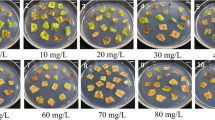Abstract
Theflavonoid 3′,5′-hydroxylase (F3′,5′H) gene, derived from petunia, was introduced into chrysanthemum tissues by Agrobacterium-mediated genetic transformation. Cotyledon expiants were co-cultured withA. tumefaciens LBA 4404 harboring the vector pMBP that carriesF3′,5′H under the control of the CaMV 35S promoter andnptll as a selectable marker gene. After 72 h of co-cultivation, the expiants were placed on an MS medium supplemented with 4 mg L-1 BA, 0.1 mg L-1 NAA, 400 mg L-1 carbenicillin, and 100 mg L-1; kanamycin. After 4 weeks, kanamycin-resistant adventitious shoots had developed at a frequency of 6.3%. These shoots were then rooted and acclimatized in potting soil. Integration ofF3′,5′H into the plant genome was confirmed by Southern blot analysis. Flower buds that had red petals did not differ between the transgenic and the wild-type plants. However, petal color did change from red to bright orange to yellow when the buds developed into fully opened flowers on the transgenics. Spectrometric analysis revealed that the content of flavonoid compounds was more rapidly reduced in the transgenic petals as floral development proceeded. RT-PCR analysis showed thatF3′,5′H andflavonoid 3′hydroxylase (F3′H) were expressed simultaneously in the transgenic plants. Therefore, we suggest that this more rapid change in petal color results from 1) competition between levels of transgenicF3′,5′H and endogenousF3′H, each of which uses the same substrate in the flavonoid biosynthetic pathway and 2) the intrinsic substrate specificity of chrysanthemumDFR (dihydroflavonol 4-reductase).
Similar content being viewed by others
Literature Cited
Baysdorfer C, Robinson JM (1985) Metabolic interactions between spinach leaf nitrite reductase and ferredoxin-NADP reductase: Competition for reduced ferredoxin. Plant Physiol77: 318–320
Brugliera F, Barri-Rewell G, Holton TA, Mason JG (1999) Isolation and characterization of a flavonoid 3′-hydroxylase cDNA clone corresponding to the Ht1 locus ofPetunia hybrida. Plant J19: 441–451
Chung KM, Park YD (2005) Development of an Agrobacterium-mediated transformation system for regenerating garland chrysanthemum (Chrysanthemum coronarium L). J Plant Biol48: 136–141
Courtney-Gutterson N, Napoli C, Lemieux C, Morgan A, Firooza-bady E, Robinson KE (1994) Modification of flower color in florist’s chrysanthemum: Production of a white-flowering variety through molecular genetics. Biotechnology12: 268–271
Dixon RA, Steele CL (1999) Flavonoids and isoflavonoids — a gold mine for metabolic engineering. Trends Plant Sci4: 394–400
Forkmann G (1991) Flavonoids as flower pigments: The formation of the natural spectrum and its extension by genetic engineering. Plant Breed106: 1–26
Forkmann G, Martens S (2001) Metabolic engineering and applications of flavonoids. Curr Opin Biotechnol12: 155–160
Fukai S, Jong JD, Rademaker W (1995) Efficient genetic transformation of chrysanthemum (Dendranthema grandiflorum (Ramat.) Kitamura) using stem segments. Breed Sci45: 179–184
Holton TA, Cornish EC (1995) Genetics and biochemistry of anthocyanin biosynthesis. Plant Cell7: 1071–1083
Holton TA, Brugliera F, Lester DR, Tanaka Y, Hyland CD, Menting JG, Lu CY, Farcy E, Stevenson TW, Cornish EC (1993) Cloning and expression of cytochrome P450 genes controlling flower colour. Nature366: 276–279
Johnson ET, Ryu S, Yi H, Shin B, Cheong H, Choi G (2001) Alteration of a single amino acid changes the substrate specificity of dihydroflavonol 4-reductase. Plant J25: 325–333
Jong JD, Mertens MMJ, Rademaker W (1994) Stable expression of Gus reporter gene in chrysanthemum depends on binary plasmid T-DNA. Plant Cell Rep14: 59–64
Ledger SE, Deroles SC, Given NK (1991) Regeneration and Agro-bacterium-mediated transformation of chrysanthemum. Plant Cell Rep10: 155–159
Lee Y, Yoon HR, Paik YS, Liu JR, Chung WI, Choi G (2005) Reciprocal regulation ofArabidopsis UGT78D2 and BANYULS is critical for regulation of the metabolic flux of anthocyanidins to condensed tannins in developing seed coats. J Plant Biol48: 356–370
Mazza G, Cacace JE, Kay CD (2004) Methods of analysis for anthocyanins in plants and biological fluids. J AOAC Intl87: 129–45
Mol JNM, Stuitje AR, van der Krol A (1989) Genetic manipulation of floral pigmentation genes. Plant Mol Biol13: 287–294
Murashige T, Skoog F (1962) A revised medium for rapid growth and bioassays with tobacco tissue culture. Physiol Plant15: 473–496
Sherman JM, Moyer FW, Doub ME (1998) A regeneration and Agrobacterium-mediated transformation system for genetically diverse chrysanthemum cultivars. J Amer Soc Hort Sci123: 189–194
Shimada Y, Nakano-Shimada R, Ohbayashi M, Okinaka Y, Kiyokawa S, Kikuchi Y (1999) Expression of chimeric P450 genes encoding flavonoid-3′,5′-hydroxylase in transgenic tobacco and petunia plants. FEBS Lett461: 241–245
Shirley BW (1996) Flavonoids biosynthesis: New functions for an old pathway. Trends Plant Sci1: 377–381
Shirley BW, Kubasek WL, Storz G, Bruggemann E, Koornneef M, Ausubel FM, Goodman HM (1995) Analysis ofArabidopsis mutants deficient in flavonoid biosynthesis. Plant J8: 659–671
Tanaka Y, Tsuda S, Kusumi T (1998) Metabolic engineering to modify flower color. Plant Cell Physiol39: 1119–1126
van der Meer IM, Stuitje AR, Mol JNM (1993) Regulation of general phenylpropanoid and flavonoid gene expression,In DPS Verma, ed, Control of Plant Gene Expression. CRC Press, Boca Raton, FL, USA, pp 125–155
Winkel-Shirley B (2001) Flavonoid biosynthesis. A colorful model for genetics, biochemistry, cell biology, and biotechnology. Plant Physiol126: 485–493
Yoshida K, Toyama-kato Y, Kameda K, Kondo T (2003) Sepal color variation ofHydrangea macrophylla and vacuolar pH measured with a proton-selective microelectrode. Plant Cell Physiol44: 262–268
Author information
Authors and Affiliations
Corresponding author
Rights and permissions
About this article
Cite this article
Seo, J., Kim, S.W., Kim, J. et al. Co-expression offlavonoid 3′ 5′-hydroxylase andflavonoid 3′-hydroxylase Accelerates Decolorization in Transgenic Chrysanthemum Petals. J. Plant Biol. 50, 626–631 (2007). https://doi.org/10.1007/BF03030605
Received:
Accepted:
Issue Date:
DOI: https://doi.org/10.1007/BF03030605




